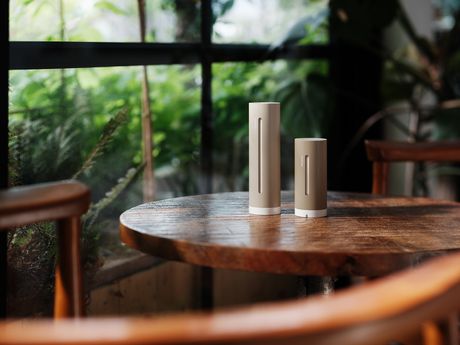
Netatmo unveils the new Weather Station ORIGINAL

Up to 50% off selected productsBuy

All types of fire extinguishers essentially work in the same way – we’ll take a closer look at the various types out there a little further down.
Inside the cylinder-shaped body, there’s a flame-extinguishing substance stored in pressurised conditions.
When the fire extinguisher is used, this substance is sprayed out through the extinguisher’s nozzle as accurately and as forcefully as possible.
Fire extinguisher nozzles are specially designed to give users as much control as possible over where they spray the extinguishing substances, despite the fact that they’re released at speed.
The PASS system is a great way to easily remember:
P: Pull out the pin on the top of the extinguisher to break through the tamper-proof protection
A: Aim the extinguisher down low, with its nozzle directed at the base of the fire you’re aiming to extinguish
S: Squeeze the handle of the extinguisher firmly to release the extinguishing substance
S: Sweep the nozzle from one side to the other, keeping it pointed at the base of the fire
If the fire isn’t completely extinguished by the time you’ve reached the end of the PASS steps, repeat the final 3 steps in the process until the flames are out.
The PASS steps apply to all types of fire extinguishers. So, no matter the type of fire extinguisher you choose, make sure you’ve got the PASS steps committed to memory!
Did you know that faulty electrical appliances and installations are a major cause of home fires? That means it’s important that you choose home fire extinguishers suitable for use on electrical fires (read on for more information!) You should also take all possible precautions within your home to ensure that your electrical appliances and installations are safely set up, as well as checking them regularly.
Take a look at the side of your chosen fire extinguisher and you’ll see a letter, or a combination letter code.
This will tell you what types of fires the extinguisher can be used to put out. There are four classes of fire extinguisher:
Class A: will put out fires fuelled by standard combustible materials, such as wood
Class B: these are designed for use on flammable liquids, such as oil or grease
Class C: extinguishers in this class are only suitable for electrical fires
Class D: designed for use on fires fuelled by flammable metals
Many fire extinguishers are designed to be able to deal with multiple types of fires, so you’re likely to see models labelled AB, BC or ABC, for example, alongside the straightforward A, B, C and D classes.
The various types of fire extinguishers spray different agents onto a fire in order to extinguish the flames.
Powder fire extinguishers are most often recommended for use in the home, so consider installing these if you’re looking to increase fire safety in a domestic property.
When used, these fire extinguishers spray a chemical-based powder that effectively smothers the flames and attacks the source of the blaze.
Powder fire extinguishers are able to put out fires that come under classes A, B and C, so are also often referred to as ABC extinguishers.
But, there are some drawbacks to powder fire extinguishers that it’s important to bear in mind.
The powder used in these types of fire extinguishers does contain chemicals, so it may cause damage to some of the surfaces with which it comes into contact inside the home.
Using powder fire extinguishers may also decrease visibility levels in an emergency situation.
These types of fire extinguisher contain water enriched with additives that help to combat the fire at its source.
These extinguisher models only comply with classes A and B, so they’re slightly less versatile than powder fire extinguishers.
The additives used in water fire extinguishers are often irritants, so users should take extra care to avoid bringing the extinguishing agent into contact with their skin.
Gas fire extinguishers decrease the quantities of oxygen surrounding a fire, therefore impacting its ability to continue burning.
As they’re cleaner than powder, water or foam fire extinguishers, gas models are a very practical option.
For user safety, it’s important to bear in mind that the gas emitted by these types of fire extinguishers is extremely cold and may cause frostbite.
Foam fire extinguishers are also widely used, but present one major drawback: they can’t be used on electrical appliances, which are a common source of fires in domestic properties.
If you’re considering installing fire extinguishers in your home to up your fire safety, it may be wiser to install powder, water or gas extinguishers.
How often do fire extinguishers need to be replaced?
To comply with guidelines, you’ll need to replace all powder, water and foam fire extinguishers once every 5 years. Gas fire extinguishers have double the lifespan and should be replaced every 10 years.
What should you bear in mind when you’re choosing fire extinguishers?
Price will vary depending on the type of fire extinguisher you select (powder, water, gas or foam). Plus, the larger the capacity of your fire extinguishers, the more expensive they’re likely to be.
You’ll need to ensure that your fire extinguishers are in easily accessible locations around the property. You should consider installing clear instructions for use (including pictorial diagrams) next to the extinguishers. It’s also important to install the fire extinguishers out of the reach of young children, so they won’t accidentally cause any damage to themselves or the extinguishers.
Consider how easy the fire extinguishers will be to use in an emergency – if they’re too heavy, that could impede how effectively they can be used to put out a fire.